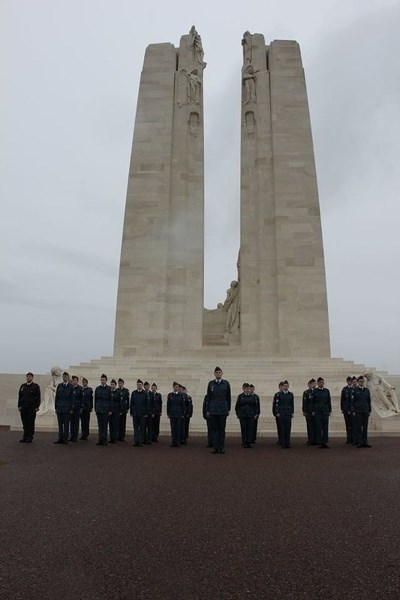Before they left St. Albert, the 28 youths from 533 Royal Canadian Air Cadet Squadron expected their spring-break trip to see the battlefields of Europe would be emotional.
Before they left St. Albert, the 28 youths from 533 Royal Canadian Air Cadet Squadron expected their spring-break trip to see the battlefields of Europe would be emotional.
It was, of course, especially when they visited the Vimy Ridge memorial in France and Flanders Fields, but perhaps the biggest learning experience many found was to realize their own proud sense of nationalism.
The cadets, aged 13 to 18 visited Holland first and it was there, in a small market café in Amsterdam, on the first day of the trip, where, to their surprise, several of the youths were honoured in an unusual way.
“In Amsterdam in a little café we were standing in line to get a hotdog. An older gentleman, perhaps 50 or 60 years old, asked me about our Squadron jackets. He asked if we were American. I said, ‘We're Canadian cadets.' When I said that, he and his friend offered us their seats. He told me, ‘You sit here! Sit! Sit here!' '' Sgt. Ashton Snelgrove said.
Snelgrove, 16, attends Bellerose High School. He and his friend had to catch up with other cadets so they thanked the man and left. There was some confusion between their understanding of Dutch and the gentleman's understanding of English, so Snelgrove can only speculate as to why a man his grandfather's age would stand up and offer him his chair.
“It may be that Holland is grateful to Canada. I can't say if that's why he offered us his chair. All I can say is ‘Wow'!” Snelgrove said.
Planning for the trip to tour the European battlegrounds of the First and Second World Wars began two years ago. The trip cost $3,600 and each of the cadets and the 17 parents and cadet leaders who travelled with them paid their own way with the help of some supplementary costs paid by fundraising endeavours.
“It was absolutely worth it. It was an opportunity to teach the cadets about Canada's battlefields. It's the first time in the history of the squadron that we've had an undertaking like this one,” said 533 Squadron leader Captain Andrew Lejeune.
Historical connections
Some of the truths about war came unexpectedly to the cadets as they began to understand the enormity of what people suffered during the world wars.
“For me the most heartbreaking moment was in Amsterdam when we went to the Jewish Deportation memorial,” said Cadet Sgt. Laura Welling, a Grade 10 student at Ecole Secondaire Sainte Marguerite d'Youville (ESSMY).
The memorial commemorates the names of more than 18,000 Jews who passed through on their way to German concentration camps.
Her own heritage is not Jewish. Nonetheless, Welling found herself searching the list of names.
“I looked for my mother's maiden name and it wasn't there. Then I looked for my grandmother's maiden name and it wasn't there. Then I looked for my own name. I searched for ‘Welling' and there was a Welling on the memorial. To see that last name on the wall really had an impact,” Welling said.
There was a similar search for a connection at the Vimy Ridge memorial, where the St. Albert cadets marched in uniform. Some looked for the names of their great grandfathers or uncles but whether they had a relative that fought there or not, they all felt the pride of being Canadian.
“We saw the trenches and we saw the conditions the soldiers would have lived in. When we were marching up the stairs – all in step – at Vimy Ridge, in the same place where the Canadians fought and won a victory, I felt very Canadian,” said Cadet Flt. Cpl. Nathan Szucs, 13 and a student at ESSMY.
Ironically, the day was foggy and cold, just as it reportedly was in April 1917, when the Canadians celebrated victory at Vimy Ridge.
As the cadets marched away from Vimy Ridge, Snelgrove noticed a group of French sea cadets who were standing along the road.
“As we were coming up, they formed a line and stood at ease, as if to pay us respect. I've marched in lots of cadet parades but I was never so proud,” Snelgrove said.
Flanders Fields
In Belgium, near Ypres, where John McCrae wrote In Flanders Fields the cadets toured the cemetery. Viewing the gravesite of a 15-year-old British soldier, who died in 1916, caused every cadet to grieve. Many of them are the same age.
“That was more emotionally turning than I thought it would be,” said Welling. “I never thought that people the same age as me, the same size as me, and from the same place as me would be there.”
The closeness of the graves bothered Snelgrove.
“The sad thing is every grave is only a few inches apart. I don't think many of them had coffins. There would have been no time for coffins. I had a cross that I wore. I took off the cross and put it on that 15-year-old's grave and left it there for him,” said Snelgrove.
Most of the 533 Air Cadet Squadron members take part in the annual Remembrance Day parade but paying tribute next November will have a different meaning for these youths, Welling said.
“Seeing how those soldiers served in honour of their country made it more real. I get the chills just thinking about Remembrance Day. I think I'll feel honoured to march but I also will be thinking about how far we've come. I'll think about how far Canada has come,” she said.
